Understanding Resilience for Food and Nutrition Security
A resilience framework can help bolster support for interventions, such as safety-net programs, that bridge relief and development.
Box 3.1
The Global Hunger Index and Exposure to Meteorological Disasters
Not only the magnitude or frequency of a shock or stress, but also social, economic, and ecological factors characterizing a household, a community, a region, or a country determine whether exposure to risk will turn into a disaster or whether absorption, adaptation, or transformation is possible (Bündnis Entwicklung Hilft 2012). Existing food and nutrition insecurity is one factor that increases vulnerability to shocks and stresses.
The graph below shows selected developing countries according to both their existing vulnerability (represented by the GHI score) and their exposure to shocks (represented by the average share of the population affected by extreme weather events, mostly droughts and floods, in 1990–2009).
Countries fall into four quadrants of the graph. The first quadrant shows countries that are less vulnerable to shocks (with a GHI score of less than 10) and less exposed (with a disaster incidence of less than 2 percent). The second quadrant shows countries that are currently less vulnerable but still highly exposed to shocks, such as China.
Countries in the third quadrant have high GHI scores but relatively low exposure to weather shocks (note that Haiti has been exposed to other kinds of shocks such as earthquakes). Such countries are very vulnerable to weather shocks, but less frequently exposed to them compared with countries in the fourth quadrant. Many of the countries in the fourth quadrant are perennially vulnerable to floods and droughts, including those in the Horn of Africa (Eritrea, Ethiopia, Kenya), the Sahel (Chad, Niger, Sudan), Southern Africa (Malawi, Zambia), and South Asia (Bangladesh, India). Not surprisingly, these regions receive the bulk of the humanitarian assistance and also see most of the major international resilience-building efforts.
Several decades ago, short-term shocks were only of peripheral concern to most development experts. Helping people survive natural disasters, like floods and droughts, or manmade ones like civil unrest, was considered the responsibility of humanitarian aid organizations. Conversely, humanitarian agencies have historically focused mainly on relief rather than on the kinds of longer-term development-oriented interventions that might reduce exposure or vulnerability to shocks.
Since then our understanding of the role of short-term shocks has evolved substantially. Even temporary shocks and stressors can have long-term consequences. A poor harvest that reduces a child’s food intake, even temporarily, can have serious effects on her longer-term cognitive and physical development and therefore future earning capacity.
A severe drought that leads a family to sell off its most productive assets, such as its land or livestock, can plunge that family into permanent poverty. It is therefore now widely recognized that a central reason why it is so difficult for poor people to escape poverty is their sheer inability to avoid or cope with shocks and stressors. Yet, at the same time, relief efforts, important though they are, do not typically address the underlying structural vulnerabilities of a population. Recognizing these realities, both the humanitarian and development communities have arrived at a common conclusion: Poor and vulnerable populations need greater resilience, and in order to achieve it, these communities need to work together.
A critical part of building resilience involves boosting food and nutrition security. Poor people have always been vulnerable to “hunger seasons,” droughts, floods, and other natural and man-made disasters (Box 3.1, right and below). In recent years, this perennial vulnerability has been exacerbated by food price and financial crises, and large-scale humanitarian crises such as the recurring droughts and famines in the Sahel and the Horn of Africa.
Several recent crises have even spurred the creation of large-scale programs that explicitly aim to build resilience, including the Global Alliance for Action for Drought Resilience and Growth in the Horn of Africa backed by USAID and the Global Alliance for Resilience in the Sahel (AGIR-Sahel) funded by the European Union (EU). Dozens of other international development projects are being created all over the world to strengthen people’s resilience to shocks and improve their food and nutrition security.
While there is no consensus on the best ingredients for resilience or even its definition, the development and relief communities are clearly moving toward a loosely defined resilience framework that offers the potential for traditionally compartmentalized sectors to design and implement more effective and more integrated interventions. Nevertheless, this emerging resilience framework presents challenges—conceptually, empirically, and practically.
The Concept of Resilience
 Source: Authors.
Source: Authors.
Resilience has roots in the Latin word resilio, meaning “to jump back” (Klein, Nicholls, and Thomalla 2003). Much of the resilience literature broadly defines the term as a return to an original state.
In ecology, resilience has long been concerned with a system’s ability to absorb changes and still persist (Holling 1973). Other resilience studies have focused on the gap between original states and less than ideal conditions. In the 1940s and 1950s, for instance, psychologists studied the negative effects of exclusion, poverty, and traumatic stressors on vulnerable individuals, especially children (Glantz and Johnson 1999). The concept was later adopted in other disciplines, including physics and disaster risk management, with a similar focus on recovery from shocks, or even adverse trends such as rapid population growth.
In the development community, the concept of resilience has been further adapted and elaborated. When applied to complex adaptive systems, resilience is not just about resistance to change and going back to how things were (Folke 2006). It can involve making adjustments to respond to new stresses or even making considerable changes to a system, be it a household, community, or country. Resilience here consists of three capacities that respond to different degrees of change or shocks (Berkes, Colding, and Folke 2003; Walker et al. 2004):
-
Absorptive capacity covers the coping strategies individuals, households, or communities use to moderate or buffer the impacts of shocks on their livelihoods and basic needs.
-
Adaptive capacity is the ability to learn from experience and adjust responses to changing external conditions, yet continue operating.
-
Transformative capacity is the capacity to create a fundamentally new system when ecological, economic, or social structures make the existing system untenable.
According to this broader definition, resilience is the result of not just one, but all three capacities. Each capacity leads to a different outcome: (1) absorptive capacity leads to endurance (or continuity); (2) adaptive capacity leads to incremental adjustments or changes; and (3) transformative capacity leads to transformational, system-changing responses (Figure 3.1).
These three different responses can be linked to different intensities of shock or change in a broadly hierarchical manner. The lower the intensity of the shock, the more likely the household, community, or system will be able to resist it effectively, absorbing its impacts without changing its function, status, or state. For example, a family would be better able to deal with a short-term food price hike—without making drastic changes—than a tsunami that levels its village.
When the shock or stressor exceeds this absorptive capacity, however, individuals and communities will then exercise their adaptive resilience, which involves making incremental changes to keep functioning without major qualitative changes in function or structure. These adjustments can take many forms. Examples include adopting new farming techniques, diversifying one’s livelihood, taking out loans, and connecting to new social networks. These adaptations can be individual or collective, and they can take place at multiple levels, such as among or between households, individuals, or communities.
If, however, those incremental changes associated with adaptive capacity are not enough to prevent a household, community, or system from avoiding dire circumstances, a more substantial transformation must take place. These changes permanently alter the system or structure in question. For example, droughts in the Horn of Africa may push people out of pastoralism and into sedentary agriculture or urban occupations, because they can no longer rebuild their herds (Lybbert et al. 2004; Box 3.2).
Importantly, these changes may not always be positive in the long run, even if they prevent people from falling into acute poverty that puts their access to basic necessities such as food and shelter at risk. In the example described in Box 3.2, those who transition out of pastoralism may fare worse than active pastoralists, since sedentary agriculture is highly risky in arid conditions.
Strengths of a Resilience Framework
Box 3.2
Resilience in Theory and Practice: A Story of Three Communities
Barrett and Constas (2012) define resilience as a situation in which, over time, a person, household, or community is non-poor and food secure in the face of various stressors and shocks. Only if that likelihood is high and remains so can that person, household, or community be considered resilient. What might this mean in practice? Here we take an example of three hypothetical communities from the real-world setting of African pastoralism at three points in time: before drought, the peak of the drought, and after drought.
-
Community A is relatively resilient. It has three assets that make it so. First, it has a large cattle herd. This means that, even though a drought will kill much of its herd, the community still has enough cattle after drought to rebuild the herd and maintain pastoralism as a viable livelihood. In other words, it has absorptive capacity. Second, Community A has the ability to graze and water its animals over a large and diverse geographical area. This herd mobility allows the community to move its animals from the most drought-affected to the least drought-affected areas and to change its migration strategy when needed. It thus has adaptive capacity. Finally, in the wake of previous droughts, some community members left to work in the capital city, where droughts have little or no effect on wages and the remittances sent home. In fact, the community uses these remittances as a form of insurance and to build up assets. So it also has built up its transformative capacity. At the end of the drought, Community A actually has gained a greater ability to withstand future shocks.
-
Community B is on a path to increasing vulnerability, although some indicators might suggest otherwise. It has lost the ability to absorb drought impacts through the traditional strategy of moving cattle and rebuilding the herd. As a result, at the peak of the drought it decides to resort to violence to appropriate the herds, grazing land, and water resources of other groups. Like Community A, Community B has largely maintained its current well-being, but at the cost of other groups’ welfare. Moreover, its cattle-rustling strategy incurs the risks of punishment and further violence, thereby reducing the community’s future capabilities.
-
Community C becomes even poorer and more vulnerable. This community’s herd is much smaller, and its grazing and watering mobility have been substantially reduced by a mix of land enclosures, tribal conflict, and irrigation developments. When drought strikes, the herd is badly hit, and the community is left with too few cattle to rebuild the herd to a viable size. Community C becomes dependent on emergency relief, and its members switch to a new livelihood that is more diversified but also less remunerative: a mix of sedentary mixed crop-livestock farming and casual labor. Without external assistance, it will likely remain in this poverty trap.
Adopting resilience as an analytical framework could help in the fight against food and nutrition insecurity for several reasons. Resilience helps frame problems coherently and holistically. Linking interrelated short-term shocks and long-term systemic change gives us a more complete view of the factors that lead people to drift into poverty, food and nutrition insecurity, or both. By giving greater weight to the significance of negative shocks than earlier development frameworks did, this concept of resilience highlights how an inability to cope with shocks makes it hard for the poor to escape poverty and explains why others fall into it in the first place (McKay 2009; World Bank 2006).
A resilience framework has practical implications, as well. It may serve as a “mobilizing metaphor” (Béné et al. 2012) to integrate traditionally disparate sectors—particularly the relief and development sectors—and encourage them to work together (USAID 2012). It may also help bolster support for interventions, such as safety-net programs, that bridge relief and development. More integrated multi-sectoral programs and collaborations could adopt a more systemic and holistic approach to fighting both chronic and transient poverty compared with many of today’s piecemeal approaches.
Another practical advantage of using a resilience framework is that it has focused more attention on understanding the welfare and behavioral dynamics of vulnerable populations, including better measurement of transient poverty as well as food and nutrition insecurity.
The analysis and understanding of local dynamics are key to identifying existing and potential self-help competencies and capacities. It is essentially those competencies and capacities that must be built up to increase individuals’, households’, local communities’, and states’ ability to absorb, to adapt, and to transform.
The “resilience lens” thus reaffirms the importance of identifying and strengthening local structures and supporting them in performing their roles effectively and working together. These structures include organizations as diverse as central or decentralized administrations, health centers, disaster risk management committees, and associations of small-scale producers.
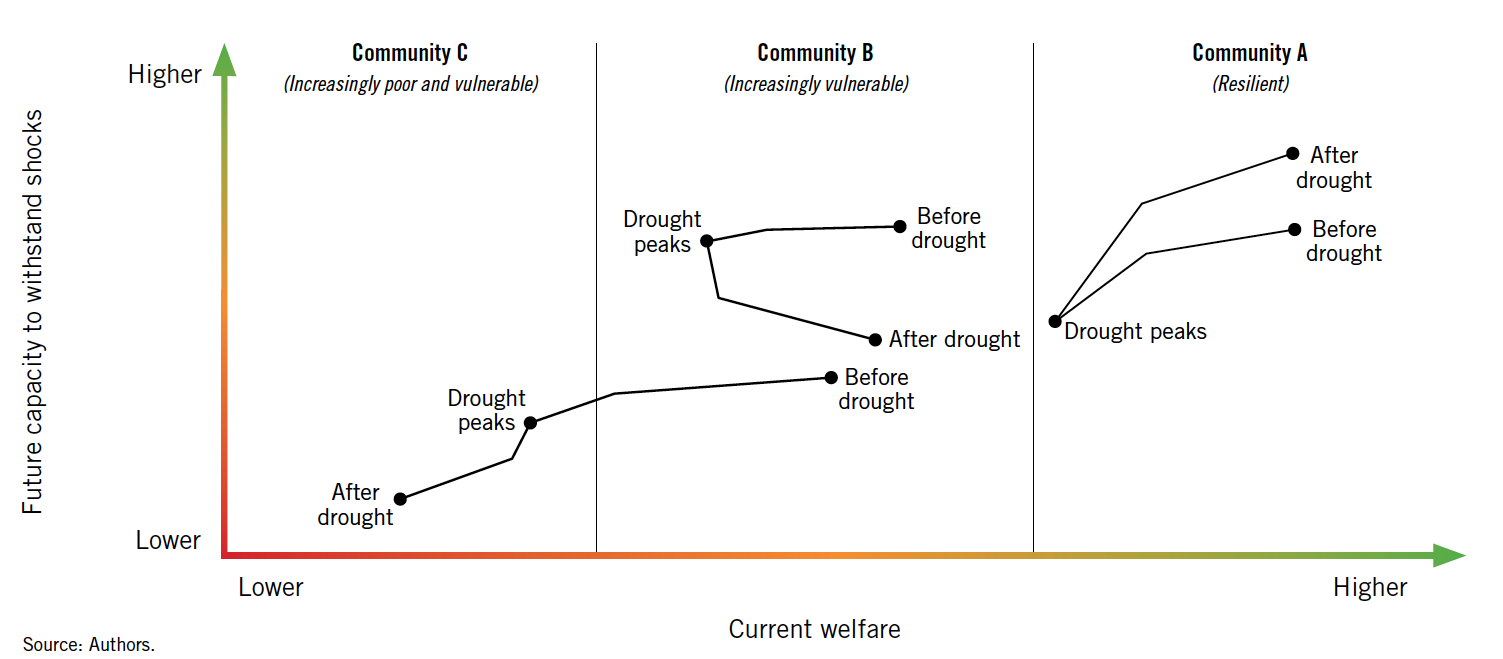
Challenges of Applying a Resilience Framework
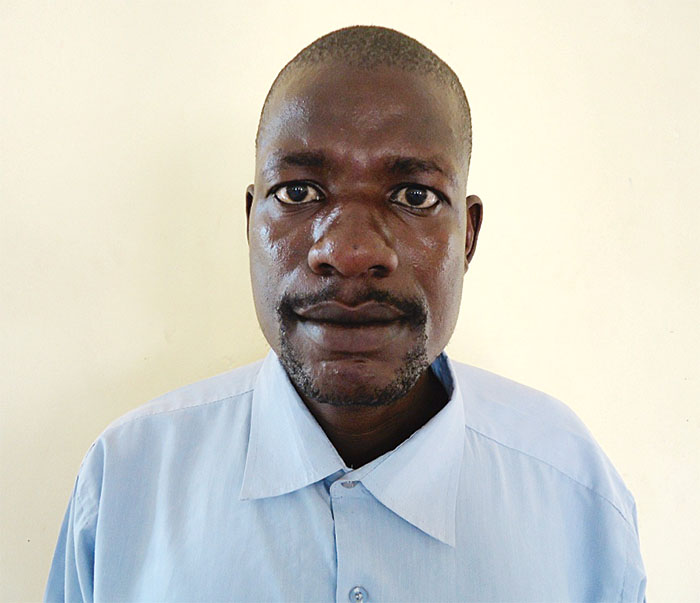
Bosco Ogwang
Lira District, Uganda
If children cannot eat enough food, it can be stressful to attend daily classes, study, and concentrate. The current food scarcity in the region will affect children’s concentration in school and could, if it continues, lead to a higher dropout rate from school.
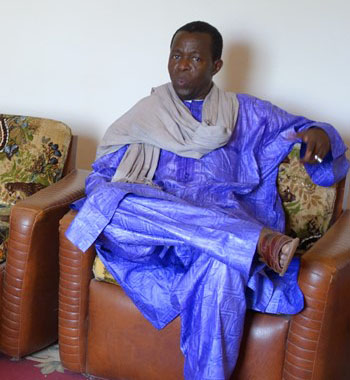
Maïga Mahamane
Employee of Welthungerhilfe, Mali
In 2012 we were beset by several crises: a nutrition security crisis, a politics and security crisis, and at the same time a humanitarian crisis. It was the first time we in Mali had to endure such a time of instability. Civil servants abandoned their offices, and the people in occupied areas had no one to turn to for help....
To prepare for the future, one has to consider that Mali is located in the Sahel, which is affected by climate change. The majority of the population depends on the wet season to ensure their food security. To improve their situation, they must pursue long-term activities to improve their production systems, to equip them with the necessary information, and to diversify their diet.
While the resilience framework seems to offer many benefits in theory, it faces many challenges in practice. First and foremost, experts in development and humanitarian circles have yet to agree on a common definition of resilience. Too often the definitions adopted tend to emphasize a return to initial states, which hardly seems consistent with promoting transformation and development.
Some critics have also suggested that resilience is a concept that does not translate well from ecological settings to social settings. They argue that the resilience model does not pay enough attention to social dynamics in general, and to issues of agency and power in particular. However, NGOs and other practitioners increasingly challenge this view. They emphasize the resilience-enhancing role played by social processes, such as community cohesion, good leadership, and individual support of collective action (Twigg 2007; Boyd et al. 2008; Schwarz et al. 2011; VFL 2011). A rigorous assessment of the literature shows, however, that the number of these analyses is still low and the evidence thin (Béné et al. 2012).
Others fear that the resilience agenda may be pushed too far, threatening or diluting the impact of more traditional relief activities. If the relief sector’s performance is benchmarked against its contribution to resilience building, many worthwhile but more narrowly focused relief efforts could lose resources. Enthusiasm for resilience building therefore needs to be tempered by an appreciation for the need for core relief activities and the benefits of specialization.
Finally, while resilience usually has positive connotations and is the goal of many programs and projects, the large majority do not consider its possible downsides. Some coping strategies, such as prostitution or begging, may strengthen resilience, but to the detriment of well-being and self-esteem. Other coping activities, such as crime, may increase the resilience of one group to the detriment of another person’s well-being. Moreover, when defined as the rapid return to an initial state, resilience may be counterproductive in the long run. Resilience as “stickiness,” “stubbornness,” or “resistance to change” is clearly not a desirable quality in many circumstances.
These concerns are by no means academic. Populations highly exposed to climate change, such as African pastoralists, are the subject of substantial debate over whether herd recovery or diversification out of pastoralism is the best long-term objective. Similarly, the argument that safety-net programs impede out-migration from drought-prone rural areas is relevant. In such a case, resilience without transformation, in response to a stressor as significant as climate change, could be an undesirable quality in the long run.
Resilience-Enhancing Interventions
Box 3.3
Two Examples of Relief-and-Development Programmes from Ethiopia
Ethiopia is notoriously vulnerable to large-scale droughts, in both the sedentary mixed crop-livestock areas of the highlands and the mostly pastoralist lowlands. In the 1980s and 1990s, droughts left Ethiopia constantly scrambling for unpredictable humanitarian relief, particularly food aid. By the 2000s, experts agreed that this inefficient approach could leave the Ethiopian poor even worse off. It became clear that the cycle of crisis and relief was not helping the poor escape chronic poverty. They needed more help to spur the country’s longer-term economic development.
Over the next decade, Ethiopia’s government and many international development partners experimented with new programs that mixed both relief and development elements. Two such programs were the Productive Safety Net Program and the Pastoralist Livelihoods Initiative.
THE PRODUCTIVE SAFETY NET PROGRAM. In 2005, the Productive Safety Net Program set out to achieve multiple objectives. On the relief side, it aimed to improve the targeting of benefits to the most vulnerable and increase the consistency and predictability of food and cash transfers. On the development end, it focused on building community assets through a public works program for all but the most labor-constrained households. A linked Household Asset Building Program focuses on building assets at the household level. Both internationally and in Ethiopia, many consider the Productive Safety Net Program successful. Its key strengths are its coverage of 7–9 million recipients, or about 13 percent of the rural population; its unique inter-institutional coordination; its strong monitoring and evaluation and capacity to improve itself through feedback loops; and its clear impact on food and nutrition security indicators. Despite these benefits, questions about resilience-related aspects of the Productive Safety Net Program persist. Is the program climate-proofed? Should it cover urban areas? Does it inhibit migration out of unsustainably low-potential regions? And are the Productive Safety Net Program and Household Asset Building Program really graduating people out of chronic poverty?
THE PASTORALIST LIVELIHOODS INITIATIVE. Though recently extended to the pastoralist lowlands, “conventional” safety net programs such as the Productive Safety Net Program are difficult to apply to pastoralist settings because of the dominance of livestock-based livelihoods, and the greater dispersion and mobility of pastoralist populations. On a smaller scale than the Productive Safety Net Program, the Pastoralist Livelihoods Initiative adopts a unique approach to combining relief and development activities in a pastoralist setting. Severe drought is a fact of life in the arid lowlands of the Horn of Africa and has always led to cyclical booms and busts in herd sizes. Yet there is evidence of a long-term decline in herd sizes because pastoralists are unable to rebuild herds after droughts. While some debate the reasons for this trend, mounting evidence suggests that it is far more cost-effective to limit herd deaths in the first place or to ensure that pastoralists slaughter or sell their animals for cash rather than see them die of starvation or disease. Nongovernmental organizations working in pastoralist areas echoed the same complaints that spurred the development of the Productive Safety Net Program. Emergency funding and resources were too slow to mobilize at the onset of drought, leading to inefficient relief activities. The Pastoralist Livelihoods Initiative implemented two innovative approaches to resilience building. First, it focused on development activities in normal years (largely for livestock activities to grow herds). Second, it built in a “crisis modifier” approach that allowed implementing agencies to quickly reallocate resources to relief activities if a drought set in.
How does this work? The Pastoralist Livelihoods Initiative features built-in triggers to switch between relief and development. In the first phase of the initiative, agencies could set aside and access 10 percent of their allocated funds if drought triggered the crisis modifier. In the second phase, the main implementing agency (USAID/Ethiopia) developed an agreement with USAID’s relief agency to allow implementing agencies to quickly and seamlessly get more funds when the crisis modifier was triggered.
The Pastoralist Livelihoods Initiative’s “relief” strategy went beyond the normal approach to relief by protecting livelihoods—not just lives. The relief included emergency destocking and slaughter, provision of feed and water (including improved feeds to support animal milk production and child nutrition during drought), and emergency veterinary care. Like the Productive Safety Net Program, the Pastoralist Livelihoods Initiative also contained a strong focus on evaluation and adjustment. Evaluations revealed that some interventions were far more cost-effective and sustainable than others.
Sources: Personal interviews with John Graham, USAID, and Matthew Hobson, World Bank. For academic discussions of these issues, see Gilligan, Hoddinott, and Taffesse (2009) and Berhane et al. (2011) for impact evaluations of the Productive Safety Net Program and Household Asset Building Program. See Lybbert et al. (2004) for a discussion of pastoralist herd dynamics, as well as Headey, Taffesse, and You (2012, forthcoming) for a review of pastoralist livelihood issues in the Horn of Africa.As implied, a significant challenge for a resilience framework is to define exactly what value it adds to the current way of doing things. In principle, a resilience framework could add value in two ways. At a strategic level, a resilience framework could encourage governments and development partners to mainstream resilience as a policy and programmatic objective, and to coordinate difference agencies and sectors to achieve that objective. In this strategic sense, it is not obvious that new policy or program instruments are needed to achieve resilience since improved coordination and prioritization could be sufficient in themselves. However, one might also expect a resilience focus to encourage adoption of programs or policies that innovatively bridge the relief and development sectors (as opposed to specializing in one sector or the other).
This raises a question: What types of interventions might build this bridge between relief and development?
An obvious example would be safety-net programs, which meet the criteria for providing social protection, or “relief,” and contributing to development, or “longer-term resilience building.” Social protection typically takes the form of food, cash, or voucher transfers, but the development component is more varied. Transfers that are conditional often incorporate explicit development objectives, such as raising school attendance, expanding vocational training or adult schooling, increasing nutritional knowledge, and, quite commonly, building infrastructure through public works programs.
A very relevant example is the Productive Safety Net Program in Ethiopia (Box 3.3). This program was an innovative solution to two major problems:
(1) the ad hoc, uneven, and unpredictable nature of traditional transfer programs and
(2) the widely held view that excessive focus on relief was inhibiting sustainable rural development.
By combining social protection with public asset building, the Productive Safety Net Program clearly contributes to both relief and longer-term development. In that sense, it is a resilience-oriented program.
Related programs in Ethiopia and elsewhere (such as BRAC’s graduation model in Bangladesh) also focus on helping individuals and households build up business and financial skills as well as confidence and a sense of empowerment. These programs are based on the assumption that providing temporary safety from shocks is a key step toward building up assets that provide a more permanent resilience to shocks.
The Pastoralist Livelihoods Initiative is a quite different example of a relief-and-development intervention from Ethiopia (Box 3.3). While productive safety-net programs are well suited to sedentary crop or crop-livestock systems, pastoralists face unique challenges. Like crops, livestock are highly vulnerable to drought. But unlike annual crops, they are a perennial asset, like land. This makes the death of livestock during droughts potentially very costly. In extreme situations, a household may drop out of pastoralism, simply because it cannot rebuild its herd after a drought.
The Pastoralist Livelihoods Initiative is a tightly focused resilience-building program that switches between relief and development, rather than trying to address both at the same time, as the Productive Safety Net Program does. It offers one clear practical way to address the disconnect between relief and development activities. But while safety-net programs have been widely researched all over the world, more experimentation, learning, and evaluation are required for these kinds of switching programs.
Measuring Resilience
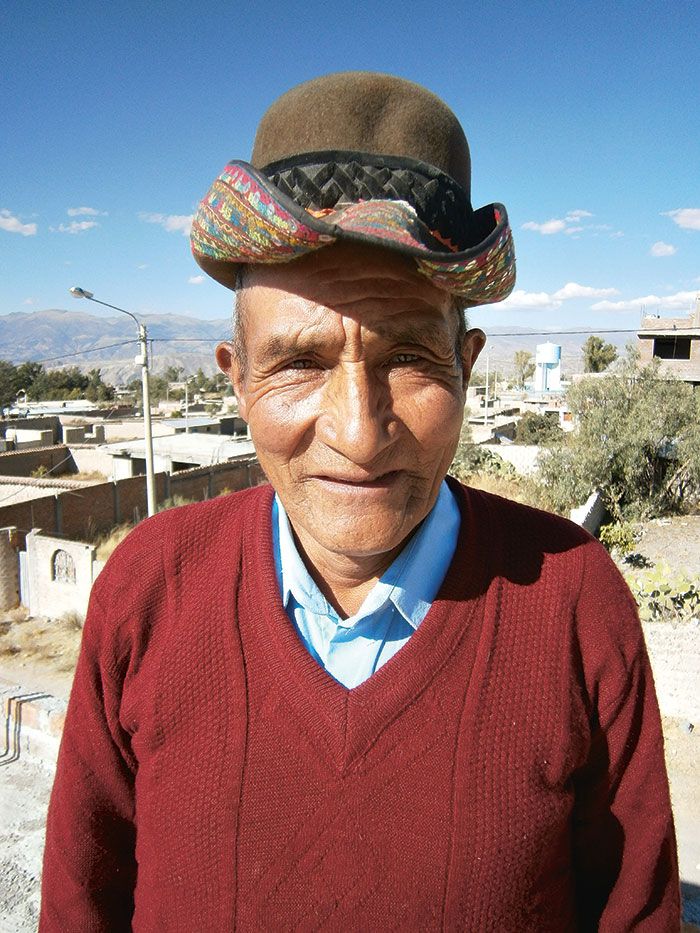
Guillermo Pacotaype
Chuschi District, Peru
I started with a project to rehabilitate the springs and creeks by setting stones around them to protect them from animal excrement and the drying sun, and by planting putaqa [Peruvian plant], which is a species that catches water well. At the community level, we have implemented the legal guidelines to protect our water sources. For example, we prohibit the drawing of water with dirty utensils or the use of soap in the water hole.
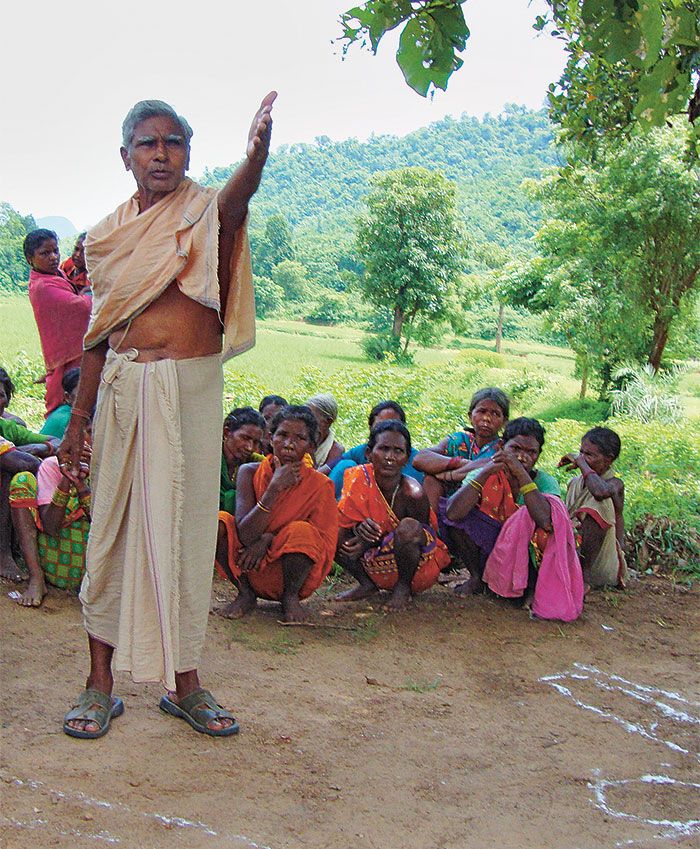
Villagers of Dukum
Rayagada District, India
We have been living in forests for generations, but our rights to the land have yet to be registered. The fact that we do not have legal ownership over much of the land on which we have been living and depend on for our food and livelihood makes us feel insecure. The lack of proper demarcation of the plots of land allocated to us... is leading to the shrinking of our land under cultivation in the forest...
Box 3.4
HELEN KELLER INTERNATIONAL’S NUTRITIONAL SURVEILLANCE PROJECTS IN BANGLADESH AND INDONESIA
Helen Keller International (HKI) set up nutritional surveillance systems in Bangladesh and Indonesia to document the effects of crises on the well-being of the poor. In Bangladesh, the system monitored the effect of disasters such as floods. In Indonesia, it was designed to monitor the effect of the Asian economic crisis of the late 1990s on nutrition and health. Over the years, these nutritional surveillance systems evolved into comprehensive, yet flexible, information systems providing timely, accurate, and important data for policy and program planning, nationally and internationally.
The indicators in HKI’s surveillance systems are based on UNICEF’s conceptual framework of the causes of malnutrition and cover areas such as the nutrition and health status of mothers and children, socioeconomic status, food production and consumption, and health service use. In Bangladesh, the nutritional surveillance project originally collected data in disaster-prone subdistricts, but in 1998 the sampling procedure was revised to be nationally and divisionally representative. Data collection takes place every two months to capture seasonal changes in nutrition and health, which allows the impact of disasters to be distinguished from seasonal effects. For example, as the top chart shows, the share of households that borrowed to cope with the 1998 floods in Bangladesh spiked to more than 50 percent from less than 10 percent over a 5-month period.
In 1998, Bangladesh experienced one of the worst episodes of flooding on record. The nutritional surveillance project was instrumental in drawing attention to the plight of flood-affected areas and in helping target public responses to populations in need. The surveillance data also showed that child wasting more than doubled from the surplus season to the lean season. Reducing such harmful effects of seasonality is an important part of building resilience.
With mounting interest in resilience as a conceptual framework comes increased demand for empirical knowledge of resilience. Governments, nongovernmental organizations, international donors, and others are interested in using the best available indicators and survey instruments to identify differences across space and time and to diagnose sources of vulnerability and design programs to address weaknesses. To diagnose the problems and develop the best responses, it is important to measure resilience by gauging the impacts of both shocks and the mitigating influences on these shocks, such as coping behaviors and outside interventions (Frankenberger and Nelson 2013). In short, good measurement should drive diagnosis and response (Barrett 2010).
A better understanding of resilience will require collecting data on the causes and consequences of a wide range of negative shocks. However, resilience, vulnerability, and coping behaviors are difficult phenomena to measure, because (1) shocks, by definition, are often short-term unpredictable events, implying the need for frequent data (for example, bi-monthly); (2) negative shocks often occur in remote places and populations, such as pastoralists in the Sahel or the Horn of Africa; and (3) resilience to shocks involves complex coping or adaptive behaviors, which are diverse and may involve thresholds and qualitative shifts.
As such, the unpredictable nature of shocks and responses to them makes measuring vulnerability and resilience much more difficult than measuring chronic welfare measures like poverty, child malnutrition, or infant mortality. For chronic measures, occasional snapshots from household surveys usually suffice to paint a general picture of poverty across regions and countries and to determine basic trends. These standard household surveys are not frequent enough, however, to assess the consequences of shocks except by coincidence, and large panel surveys in developing countries are still relatively rare. While many standard economic or health and nutrition surveys might measure important aspects of vulnerability and resilience, they are unlikely to measure all relevant behavioral responses. This suggests that measuring vulnerability and resilience requires a different approach.
What, then, are the key issues that arise when one tries to measure resilience in the context of food and nutrition insecurity? A distinguishing feature of resilience and vulnerability is the potential for complex dynamics. In vulnerable socioeconomic environments, individuals, households, and communities are likely to experience dynamic fluctuations in well-being, including a mix of long-term trends, cyclical and seasonal shocks, and major covariate shocks. Moreover, the transitions from one state, such as chronic poverty, into either better or worse states are likely to be characterized by a range of threshold effects or tipping points, such as when a drought reduces herd sizes below a threshold of recovery (Box 3.2; Lybbert et al. 2004).
Finally, resilience requires a multilevel or systemic measurement approach. This includes measurement at different levels—individual, household, community, (eco)system—and among different socioeconomic and ethnic groups. This also requires an understanding of how these different identities and factors interact. Beyond the household level, systemic factors, such as health conditions, social and political relationships, culture, agroecological factors, and macroeconomic conditions, may affect resilience.
These basic principles have important implications for measurement in practice. Table 3.1 provides a general list of proposed indicators that could be used to measure resilience for food and nutrition security. Perhaps the most important prerequisite for resilience measurement is higher-frequency surveys (Barrett 2010; Headey and Ecker 2013). Though still surprisingly rare, high-frequency measurement is a necessary condition for understanding vulnerability and resilience, because it helps identify (1) “dynamic initial states,” such as seasonality, cyclicality, and exposure to idiosyncratic shocks; (2) differences between pre-shock and post-shock states; (3) the complex dynamics of coping and adaptation mechanisms; and (4) the key thresholds that may arise in the transitions between initial and subsequent states (Barrett and Constas 2012). The more standard program evaluation based on two to three rounds of a survey (typically conducted several years apart) will rarely if ever suffice to make sense of the complexities of highly vulnerable people's lives.
The most pertinent examples of high-frequency resilience surveys are the nutritional surveillance system surveys conducted by Helen Keller International (HKI) in Bangladesh and Indonesia. The World Food Programme (WFP) also uses the nutritional surveillance system approach in some of its high-priority countries, such as South Sudan. These surveys are typically conducted every two months—more often than standard household surveys—in order to pick up the effects of both seasonal shocks and “one-time” natural disasters. Moreover, while the nutritional surveillance system surveys focus heavily on nutrition indicators, they also look at a wide range of household characteristics and coping behaviors (Box 3.4).
Beyond the need to use higher-frequency surveys, resilience measurement faces additional challenges in terms of the breadth of the resilience concept. Resilience is a highly multidimensional concept with numerous causes and manifestations. Moreover, some factors may be considered not only causes or sources of resilience, but also indicators of resilience. For example, a non-exhaustive list of factors that are simultaneously considered as “contributors” to and “results” of resilience includes: technological capacity, appropriate skills and education, gender empowerment, sustainable natural resource management, adequate livelihood assets, good governance, and access to infrastructure (Alinovi et al. 2010; USAID 2012; Tulane and UEH 2012; Vaitla et al. 2012). This clouding of the distinction between cause and effect limits our ability to compare or refute specific hypotheses (Frankenberger and Nelson 2013).
In addition, this diverse and extensive list of factors poses some serious challenges to both measurement and scientific analysis. Some of these factors are inherently difficult to measure, such as governance, natural resource management, and gender empowerment. Many must be measured qualitatively rather than quantitatively. Some indicators must be measured at the individual or household level, but others need to be measured at the community level or even higher. Finally, some factors—as well as the definition of resilience itself—are likely to be context- and shock-specific, thereby limiting comparability across survey sites. Some factors fall under one discipline, such as economics, while others fall under very different disciplines (ecology, political science, sociology). As already emphasized, most—if not all—of these factors ought to be measured in high-frequency surveys. Thus the practical challenges to effectively monitoring and measuring resilience are considerable. Yet collecting such an extensive set of data to measure resilience could help shape more informed responses to a wide range of crises.
Looking Back
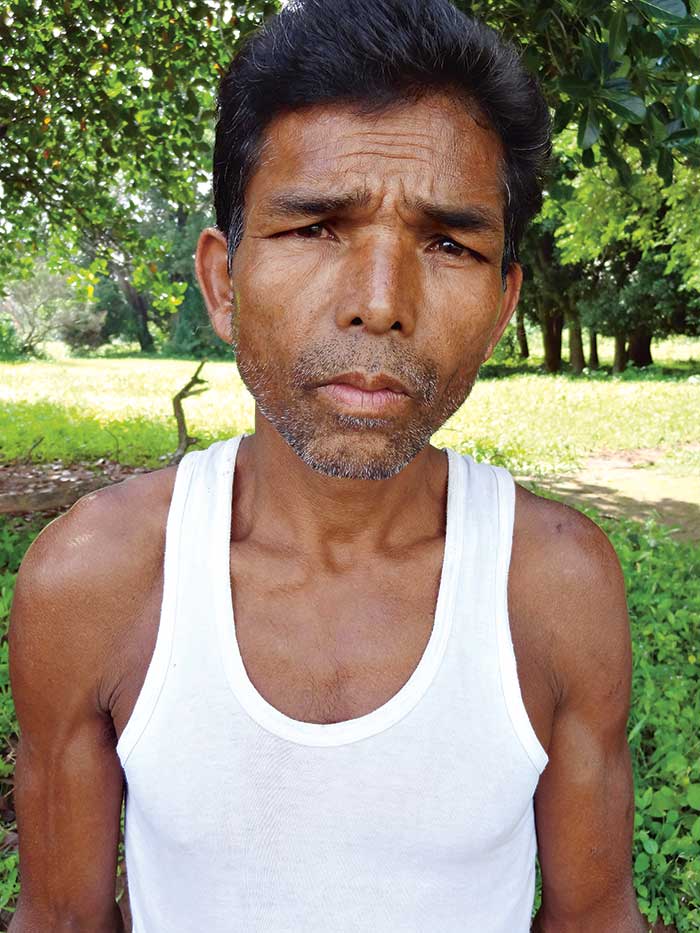
Sindhu Kumbruka
Rayagada District, India
We have been asserting our rights to the forest and filing for recognition of our community and individual forest rights. We have begun regenerating more than 4,000 hectares of degraded forest.
The complexity of the concept of resilience and the challenges of measuring and promoting it may paint a somewhat daunting picture for policymakers and development practitioners. Indeed, some vulnerable countries and regions have found themselves mired for decades in poverty and food and nutrition insecurity in the face of shocks. Other highly vulnerable countries, though, have seemingly become more resilient. Much can be learned from the varied experiences of these groups of countries.
Figure 3.2 (below) shows three countries and two sub-regions that score high on the 2013 Global Hunger Index and are exposed to weather shocks, along with their food aid receipts as a proxy for resilience over time. The food aid data reflect the standard narrative of “permanent crisis” in the Sahel and the Horn of Africa, where food aid receipts were roughly as large in 2008–2011 as they were about 20 years ago. In contrast, Malawi and Zambia (two countries where controversial fertilizer subsidy programs have greatly expanded maize production) have seen improvements in recent years, though questions remain about whether these efforts can be sustained. And finally, Bangladesh has achieved a remarkable reduction in food aid dependency. Its 85 percent drop in food aid receipts from the early 1990s to 2008–2011 is consistent with the country’s dramatic economic and social achievements (Economist 2012), including rapid agricultural growth (through new crop varieties and other modern inputs), sharp reductions in fertility rates, dramatic expansion in education (especially for females), a microfinance revolution, and sustained job creation outside of agriculture.
There is more to learn about why some vulnerable regions have made so little progress, while some shock-prone countries seem to have turned themselves around. Success stories like Bangladesh, Malawi, and Zambia, however, show that building individual, community, and national resilience within a generation is a real possibility.
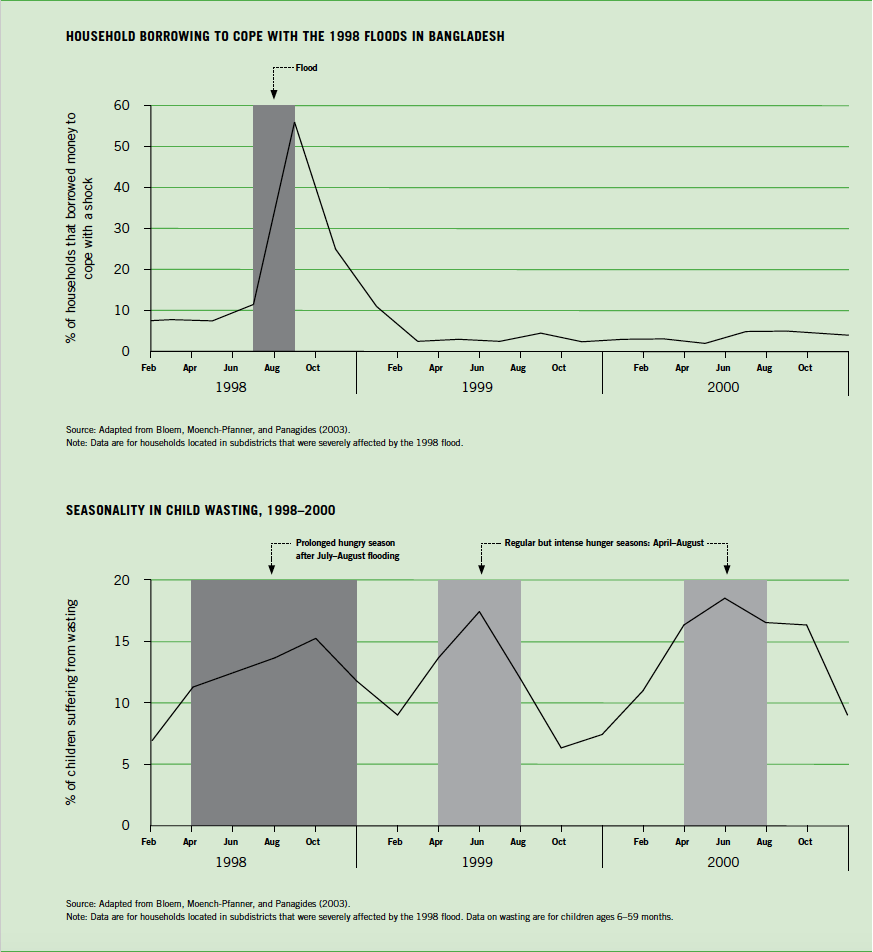
Looking Ahead
The importance of considering the building blocks of resilience is becoming more apparent to the development and relief communities, both of which have long struggled to understand why some people fare better than others when confronting stresses or shocks. Resilience is a challenging concept that has evolved across an unusually wide range of disciplines. Its increasing adoption in development circles is understandable given the mounting evidence of the close interactions between short-term shocks and longer-term development.
But while the underlying rationale for focusing on resilience building is strong, adopting a resilience framework faces many challenges. Conceptually, consensus is needed on what resilience is and what it is not; on whether resilience is desirable by definition, or whether it might include detrimental behaviors; on whether it only means bouncing back, or whether it also includes adaptive and transformative behaviors.
Empirically, measuring and monitoring resilience and its causes is not easy. Far more than chronic poverty, resilience is a dynamic concept requiring high-frequency surveys, at the very least in those countries and regions perennially exposed to severe shocks and stressors. No less challenging is the multidimensional nature of resilience and what that implies for the detailed work of survey design and scientific collaboration.
Finally on the policy and programmatic front, the resilience paradigm needs to demonstrate that it offers something substantially new, both in terms of an expanded dialogue between the traditionally disconnected relief and development sectors and in terms of innovative new programs that address both humanitarian and development objectives.
In summary, to achieve food and nutrition security, more effort is needed to protect and improve poor and vulnerable people’s ability to respond to changes and shocks. Much work needs to be done before we know whether a resilience framework is the most useful tool for building this resilience. What is sure however is that there is a growing consensus on the need to break down barriers between actors, sectors, and disciplines and that this consensus must now be converted into effective policies and practices that strengthen the resilience of the poorest and most vulnerable people.
Footnotes
- Inequality also shapes vulnerability and makes it harder for poor people to escape and manage risk, thus undermining their resilience capacities (Oxfam 2013).
- As examples, see Leach (2008); Hornborg (2009); Davidson (2010); Duit, Galaz, and Eckerberg (2010).
- Some of these livelihood strategies may be short-term “negative” coping strategies; others clearly involve longer-term maladaptations that cannot be considered simply survival coping behaviors. “Negative” forms of resilience are thus possible and often empirically observed (Sapountzaki 2007).
- Moreover, the mobility of pastoralist populations makes the range of fixed public works projects, such as the construction of roads and crop infrastructure, more limited, though they are still possible, particularly in more sedentary agro-pastoralist settings.
- See Bloem, Moench-Pfanner, and Panagides (2003) and Shoham, Watson, and Dolan (2001) for an introduction to the approach.
Authors
At the time of publication, Dr Christophe Béné was a Research Fellow in the Vulnerability and Poverty Reduction team at the Institute of Development Studies. A socio-economist and policy analyst with 15 years of experience in developing countries.
Lawrence Haddad is the former Director at the Institute of Development Studies (2004-2014). He is now a Senior Research Fellow at the International Food Policy Research Institute. He is an economist and his main research interests are at the intersection of poverty, food insecurity and malnutrition.